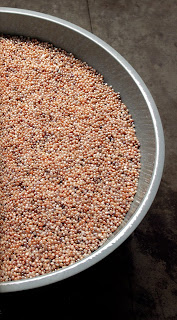Ai WeiWei at the Mori
Not that politics should be ignored. Last August Ai was among twelve people detained by Chinese police in order to prevent them from attending the trial of a dissident, Tan Zuoren. Tan is an activist whose writings on the 1989 Tiananmen Square uprising and the investigations of schoolchildren’s deaths in the 2008 Sichuan earthquake landed him in jail on charges of subversion. The Sichuan tragedy was exacerbated by the shabby construction of local schools where many children were buried alive while nearby government offices, built to a higher standard, remained standing. Without much regard for his own personal safety Ai Weiwei became a vocal critic of the government that, in the aftermath of the quake, was making no effort to release the names of the young victims. Ai set up a blog, and through a network of volunteers began to gather the information, publishing children’s names and vital statistics for the world to see. When some expressed their surprise at Ai’s altruistic social activism, he made it clear that it was his responsibility as an artist to act on behalf of those who so needed it.
The objects in the Mori galleries are about the past and present of Ai’s motherland as much as they are about his impressive knowledge of the recent and not so recent history of Western art. His 2006 wooden sculpture Untitled is a truncated icosahedron based on Leonardo da Vinci’s exploration of pure geometry published in Luca Pacioli’s 1509 De Divina Proportione. But the object’s architectural scale and its execution, using traditional Chinese joinery, suggest for it a distinct space somewhere between minimalist and the Arts and Crafts. At the same time, Ai’s painstaking searching out the right materials for the right objects—freshwater pearls, rare woods, blocs of pressed tea—makes him a rightful heir of Russian Constructivism mediated by way of minimalist experimentation (although much of his work would certainly be too metaphorical for Donald Judd). Historical reference also lurks in the antique jar with Coca-Cola label painted on it (Coca-Cola Vase, 1997) and in various liquor bottles encapsulating Tang Dynasty figurines (1993–1994). These provide a tongue-in-cheek conjuring up of Pop as they pointedly question the value of authenticity in art, whether modern or antique.
Equally witty is the 2003 Forever, an assemblage of 42 not quite functional bicycles (all missing steering bars and pedals), linked into a multi-tier circular construction. This comment on the formerly ubiquitous, now endangered, mode of transportation for the Chinese bears an ironically eternal brand name of the Forever Company—a popular bicycle manufacturer from Shanghai. The work successfully combines social/spatial metaphors with minimalist specificity. Of course, for contemporary art a bicycle in museum context is anything but a neutral object: here, Alexander Dumas’ advice on finding the culprit can be appropriately paraphrased into “cherchez Duchamp.” Ai’s use of pre-fabricated, non-art objects such as bottles, furniture and bicycle parts inevitably relates him to Duchamp, perhaps, again via minimalist adaptations of objects meant for uses other than museum display. As the artist himself wittily pointed out during the eight-hour marathon symposium held in conjunction with his exhibition: “Culture is a readymade,” and much of what is shown at the Mori runs the spectrum from specific objects to meta-comments on culture(s), all serving to get his message across.
So what is Ai’s message? The Mori show is all about breaking apart and putting together. Among the objects on display are the 1995 Dropping a Han Dynasty Urn— a photographic triptych that documents the artist’s notoriously iconoclastic act, and his 2008 Snake Ceiling,—a site-specific installation that alludes to a different kind of destruction—largely preventable deaths of schoolchildren in the Sichuan earthquake. The familiar Chinese snake is actually composed of the students’ backpacks, small ones used by preschoolers and the adult-sized ones made for the older kids. A photographic series called Provisional Landscape (2002–2008) is a deconstruction of a cityscape that changes over the period of six years as the government destroys, empties and rebuilds a neighborhood; the Map of China (2006) is a 3-D depiction of the country assembled in rare wood. In all of that building and compiling Ai relies on conceptual games of proportion, scale and multiplicity. His 2004 Chan’an Boulevard tracks the relationship of time and space as the artist filmed a minute of tape every 50 meters along the mammoth forty-five kilometer boulevard. The Bowl of Pearls (2006) is a pair of bulky bowls, each one meter in diameter, full of fresh-water pearls—their minute size emphasizing the discrepancy with their enormous quantity. Kippe (2006) is an elaborate construction of tightly laid pieces of wood from demolished temples stacked in between a set of parallel bars; the Ton of Tea (2006) is a cubic meter block of pressed Yunnan Province tea, its compressed weight measuring exactly one ton. With great humor and humility, the artist breaks down actual and visual matter into the smallest units in order to construct it anew, creating objects full of references to geopolitics and aesthetics. Still, it is not all for the eye and the brain. Ai’s Mori Museum exhibition also gratifies visitors by its multi-sensory quality. Many of the rooms first draw in the viewers through their smell—pu’er tea, exotic wood—only then revealing Ai’s mental gymnastics of scale and multiplicity, his social metaphors and his cultural palimpsests.
















I see you don’t monetize juliafriedman.net, don’t waste your traffic, you can earn extra bucks every month with
new monetization method. This is the best adsense alternative for any
type of website (they approve all websites), for more details
simply search in gooogle: murgrabia’s tools